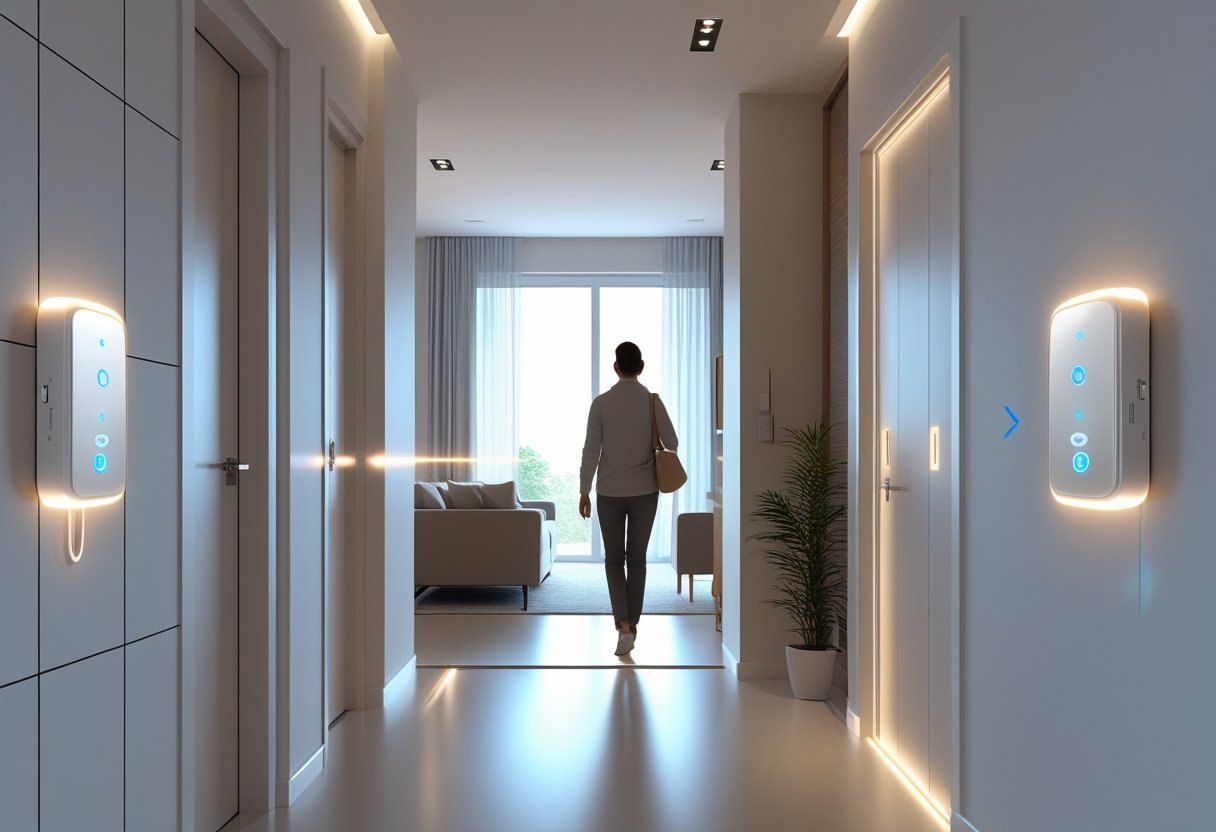Motion sensor alarms are a crucial element of modern home security. They enhance safety by detecting movement and triggering alerts, allowing you to respond quickly to potential threats. By integrating motion sensors into your security system, you can effectively monitor various areas of your home, providing peace of mind whether you are present or away.
These systems come in different types, including passive infrared (PIR), microwave, and dual-tech sensors, each serving specific needs. The advantages of using motion sensor alarms extend beyond basic intrusion detection; they can also activate lights, cameras, and other security devices, creating a comprehensive safety network tailored to your lifestyle.
If you are located in the greater Houston area, investing in a motion sensor alarm system can significantly enhance your home’s protection. With immediate alerts and a variety of options available, you can customize a security solution that meets your needs and keeps your property safe.
What Are Motion Sensor Alarms for Home?
Motion sensor alarms are critical components of modern home security systems. They detect movement within a designated area and trigger alerts or alarms, enhancing your protection against potential intrusions. Understanding their functionality, benefits, and essential components can help you select the right system for your home.
How Motion Sensor Alarms Work
Motion sensor alarms utilize various technologies to detect movement. Common sensors include Passive Infrared (PIR), microwave, and dual-tech sensors.
- PIR Sensors: These detect body heat and movement through infrared radiation.
- Microwave Sensors: These emit microwave signals and measure their reflection to identify motion.
- Dual-Tech Sensors: These combine both PIR and microwave technologies for increased accuracy.
When movement is detected, the alarm system activates, notifying you through audible alerts or notifications sent to your mobile device. This real-time detection can significantly reduce the chances of unauthorized entry.
Key Benefits for Home Security
Installing a motion sensor alarm offers numerous advantages for your home security. Here are some key benefits:
- Increased Safety: You are alerted immediately when unexpected movement is detected, allowing for timely responses.
- Deterrent Effect: The presence of alarms can discourage potential intruders.
- Integration with Smart Home Technology: These alarms can work with security cameras and home automation systems, providing enhanced monitoring capabilities.
- Energy Efficiency: Some systems can be programmed to turn off lights or HVAC systems when no movement is detected, which can save on energy costs.
With these features, motion sensor alarms play a vital role in your home safety strategy.
Essential Components of a Motion Sensor Alarm System
A typical motion sensor alarm system consists of several key components:
- Motion Detectors: The primary devices that identify movement and trigger the system.
- Control Panel: This central unit manages the entire system, allowing you to configure settings and view alerts.
- Alarm Siren: This produces an audible warning when the system is triggered.
- Notifications System: Many modern systems send alerts directly to your smartphone or connected devices.
These components work together to create a robust security framework for your home. Selecting a system tailored to your needs ensures you have the right level of protection for your property.
Types of Motion Sensor Alarms
Understanding the types of motion sensor alarms can help you make informed decisions for your home security. Each type operates differently and offers unique advantages suitable for various situations.
Passive Infrared (PIR) Sensors
Passive Infrared (PIR) sensors detect motion by sensing changes in infrared radiation emitted by objects in their field of view. They are commonly used in home security systems due to their reliability and affordability.
These sensors only trigger an alarm when they detect movement from a person or pet within a specific area. They are typically less sensitive to environmental changes, reducing false alarms.
PIR sensors often have a range of about 20 to 40 feet and can cover a broad area. They are ideal for indoor security, as they are effective in detecting motion without being easily triggered by small animals.
Microwave Sensors
Microwave sensors operate by emitting microwave signals and measuring the reflections from moving objects. This technology allows them to detect motion through walls and other obstacles, making them versatile in various environments.
You might find microwave sensors beneficial for outdoor installations or larger spaces where a broader detection range is necessary. They generally have a detection range of up to 30 meters, providing extensive coverage.
However, their sensitivity can lead to more false alarms, as they may detect movement from small animals or even vehicles. Therefore, placement is essential to minimize these occurrences while maximizing security.
Ultrasonic Motion Sensors
Ultrasonic motion sensors use sound waves to detect movement. They emit high-frequency sound waves that bounce off objects, allowing the sensor to gauge movement through changes in the echo pattern.
These sensors are effective in indoor environments, especially in hallways or rooms. They can detect motion within a range of 30 feet or more and are often used in combination with other sensor types for enhanced security.
One major advantage is their ability to differentiate between different types of motion. Ultrasonic sensors are less likely to trigger false alarms from moving objects such as pets, as they can distinguish between the size and speed of movements.
Dual-Technology Sensor Alarms
Dual-technology sensor alarms combine two different types of detection methods, usually a PIR sensor and a microwave sensor. This combination minimizes false alarms while enhancing reliability.
With this setup, the alarm only activates when both sensors detect motion simultaneously. This feature significantly reduces the likelihood of false triggers from pets or environmental factors.
These sensors are ideal for homes in the greater Houston area where security needs may vary. They provide coverage for both indoor and outdoor applications, ensuring your property remains protected without unnecessary interruptions.
Integrating Motion Sensor Alarms with Home Security
Integrating motion sensor alarms with your home security system enhances overall safety by providing real-time alerts and automated responses. These devices work seamlessly with other security features like cameras and video doorbells, creating a more robust protection network for your home.
Working with Security Cameras
Motion sensor alarms can significantly improve the functionality of your security cameras. When a sensor detects movement, it triggers the camera to start recording, ensuring that any activity is captured.
This integration allows you to monitor live feeds or review footage when an alert occurs. Set up alerts on your mobile device to receive notifications whenever motion is detected, giving you peace of mind whether you’re home or away.
Connecting to Video Doorbells
Your motion sensor can also connect to video doorbells to bolster your entryway security. When motion is detected at the door, the video doorbell activates, allowing you to see and communicate with visitors through your smartphone.
This connection enhances your home security system, as you can verify who is at your door before opening it. Many systems even allow you to record video clips triggered by motion, giving you a comprehensive view of activity around your home.
Smart Home Integration Options
Integrating motion sensor alarms into your smart home ecosystem offers numerous advantages. You can connect these alarms to a centralized home security system that coordinates with smart locks, lights, and other devices.
For example, when motion is detected, smart lights can automatically turn on, illuminating potential intruders’ pathways. This not only enhances security but also provides convenience, as you can control all aspects of your home security from one interface.
Consider utilizing platforms that support various smart devices, ensuring compatibility and maximizing the effectiveness of your home security system.
Choosing and Installing Motion Sensor Alarms
When selecting and installing motion sensor alarms, it’s essential to evaluate specific factors that impact both functionality and ease of use. Your decisions will directly affect the effectiveness of your home security system. Focus on making informed choices to enhance both safety and convenience.
Factors to Consider Before Buying
Before purchasing motion sensor alarms, consider the following aspects:
- Type of Sensor: Choose between Passive Infrared (PIR), microwave, or dual-tech sensors based on your needs. PIR sensors are effective for most residential areas, while microwave sensors can cover wider spaces.
- Range and Sensitivity: Assess the range of detection. A Vivint motion sensor typically covers up to 40 feet, making it suitable for larger areas.
- Integration: Ensure compatibility with your existing security system. Many alarms work seamlessly with smart home setups for remote monitoring.
- Weather Resistance: If installing outdoors, opt for sensors designed to withstand varying weather conditions.
These considerations will influence your purchase and enhance the functionality of your motion sensor alarms.
Best Locations for Installation
Selecting the right locations for your motion sensor alarms is critical for optimal performance.
- Entry Points: Install sensors near doors and windows to monitor potential break-ins effectively.
- High-Traffic Areas: Place sensors in hallways and common areas where motion is more likely, ensuring they cover larger spaces without obstructions.
- Outdoors: Install weather-resistant sensors along perimeters, such as driveways or patios, to detect unwanted movement while you’re away.
Avoid placing sensors where pets may trigger them, as this can lead to false alarms. Placement strategy enhances both security and convenience in your home.
Professional vs. DIY Installation
Deciding between professional and DIY installation can affect the effectiveness of your motion sensor alarms.
- Professional Installation: Hiring experts ensures optimal placement and configuration. Professionals understand sensor types and angles better, leading to efficient coverage.
- DIY Installation: If you have basic technical skills, some systems allow easy self-installation. Many units, such as certain Vivint motion sensors, come with user-friendly instructions.
When opting for DIY, consider potential setbacks, like improper placement or configuration issues that could compromise security. Weigh the benefits of professional expertise against your comfort level with technology to make the best choice.
Common Issues and Solutions
When utilizing motion sensor alarms for your home, understanding common problems and their solutions can greatly enhance your security experience. False alarms, maintenance needs, and connectivity issues are critical points to address.
Preventing False Alarms
False alarms can be frustrating and may lead to a loss of confidence in your security system. To minimize these, consider the following tips:
- Proper Placement: Make sure motion sensors are installed away from direct sunlight, heat sources, or areas with heavy foot traffic.
- Adjust Sensitivity: Many motion detectors come with adjustable sensitivity settings. Fine-tune these to reduce unintended triggers from pets or passing cars.
- Regular Testing: Schedule routine tests of your sensors to ensure they respond appropriately. This can help identify potential issues before they escalate.
Implementing these steps can help keep false alarms to a minimum, ensuring your home security remains effective.
Maintaining Motion Sensors
Routine maintenance is essential for ensuring your motion sensors function correctly. Here are some key maintenance practices:
- Battery Checks: Replace batteries as needed. Low power can affect performance. Typically, batteries should be checked every six months.
- Cleaning: Dust and debris can interfere with sensor performance. Use a soft cloth to clean the sensors regularly, particularly the lenses.
- Environmental Assessment: Regularly inspect the installation area for changes such as new furniture or landscaping that could obstruct the sensor’s line of sight.
By staying proactive with these maintenance tasks, you can extend the life of your motion sensors and reduce the likelihood of malfunction.
Troubleshooting Connectivity Problems
Connectivity issues can disrupt your motion sensor alarms, especially in a smart home setup. Here’s how to address these challenges:
- Check Wi-Fi Signal: Ensure your motion sensors are within range of your Wi-Fi network. Weak signals can lead to unreliable performance.
- Interference: Identify any electronic devices nearby that could cause interference, such as microwaves or cordless phones. Relocating your sensors or these devices may resolve issues.
- Firmware Updates: Keep your motion sensor firmware updated. Manufacturers often release updates that can improve connectivity and performance.
Taking these measures can help maintain a strong and reliable connection for your home security system, safeguarding your property in the greater Houston area.
Frequently Asked Questions
This section addresses common concerns you may have about motion sensor alarms for home use. Understanding how to select, utilize, and maintain these systems can greatly enhance your security efforts.
How do I choose the best motion sensor alarm system for my home?
When choosing a motion sensor alarm system, consider factors such as detection range, difficulty in installation, and integration with existing security systems. Assess your home layout to determine where sensors will be most effective based on entry points and areas that require monitoring.
What are the benefits of using wireless motion sensor alarms compared to wired systems?
Wireless motion sensor alarms offer greater installation flexibility and are often easier to set up. They eliminate the need for extensive wiring, reducing installation time and costs. Additionally, wireless systems can be relocated more easily if your monitoring needs change.
Can motion sensor alarms be used effectively outdoors?
Yes, certain motion sensor alarms are specifically designed for outdoor use. Such systems typically incorporate weather-resistant features and advanced technologies to minimize false alarms from environmental factors like wind or animals. Ensure you choose outdoor-rated sensors for optimal performance.
What features should I look for in a motion sensor alarm to ensure optimal security?
Look for features such as pet immunity, adjustable sensitivity, and smart home compatibility. A two-way communication feature can also be beneficial for monitoring activity remotely. Additionally, consider systems with notifications to alert you of detected movement.
How do motion sensor alarms function to detect unauthorized movement?
Motion sensor alarms typically work through infrared technology or microwave signals to detect changes in the environment. Infrared sensors monitor the heat emitted by objects, while microwave sensors emit waves that bounce off moving objects. When motion is detected, the system triggers an alarm.
Are there any maintenance tips for ensuring the longevity and reliability of home motion sensor alarms?
Regularly clean the sensors to prevent dust buildup, which can hinder performance. Test your system monthly to ensure everything is functioning correctly. Additionally, replace batteries in wireless units as needed to avoid malfunctions during critical times.
.svg)



.svg)


.svg)



